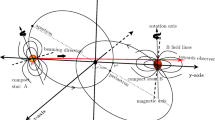Abstract
The relaxation mechanism, which solves the electroweak hierarchy problem without relying on TeV scale new physics, crucially depends on how a Higgs-dependent back-reaction potential is generated. In this paper, we suggest a new scenario in which the scalar potential induced by the QCD anomaly is responsible both for the relaxation mechanism and the Peccei-Quinn mechanism to solve the strong CP problem. The key idea is to introduce the relaxion and the QCD axion whose cosmic evolutions become quite different depending on an inflaton-dependent scalar potential. Our scheme raises the cutoff scale of the Higgs mass up to 107 GeV, and allows reheating temperature higher than the electroweak scale as would be required for viable cosmology. In addition, the QCD axion can account for the observed dark matter of the universe as produced by the conventional misalignment mechanism. We also consider the possibility that the couplings of the Standard Model depend on the inflaton and become stronger during inflation. In this case, the relaxation can be implemented with a sub-Planckian field excursion of the relaxion for a cutoff scale below 10 TeV.
Article PDF
Similar content being viewed by others
Avoid common mistakes on your manuscript.
References
P.W. Graham, D.E. Kaplan and S. Rajendran, Cosmological Relaxation of the Electroweak Scale, Phys. Rev. Lett. 115 (2015) 221801 [arXiv:1504.07551] [INSPIRE].
R.D. Peccei and H.R. Quinn, CP Conservation in the Presence of Instantons, Phys. Rev. Lett. 38 (1977) 1440 [INSPIRE].
J.E. Kim and G. Carosi, Axions and the Strong CP Problem, Rev. Mod. Phys. 82 (2010) 557 [arXiv:0807.3125] [INSPIRE].
K. Choi and S.H. Im, Realizing the relaxion from multiple axions and its UV completion with high scale supersymmetry, JHEP 01 (2016) 149 [arXiv:1511.00132] [INSPIRE].
D.E. Kaplan and R. Rattazzi, Large field excursions and approximate discrete symmetries from a clockwork axion, Phys. Rev. D 93 (2016) 085007 [arXiv:1511.01827] [INSPIRE].
A. Nelson and C. Prescod-WEinstein, Relaxion: A Landscape Without Anthropics, Phys. Rev. D 96 (2017) 113007 [arXiv:1708.00010] [INSPIRE].
J.R. Espinosa, C. Grojean, G. Panico, A. Pomarol, O. Pujolàs and G. Servant, Cosmological Higgs-Axion Interplay for a Naturally Small Electroweak Scale, Phys. Rev. Lett. 115 (2015) 251803 [arXiv:1506.09217] [INSPIRE].
M. Kawasaki and K. Nakayama, Axions: Theory and Cosmological Role, Ann. Rev. Nucl. Part. Sci. 63 (2013) 69 [arXiv:1301.1123] [INSPIRE].
E. Berkowitz, M.I. Buchoff and E. Rinaldi, Lattice QCD input for axion cosmology, Phys. Rev. D 92 (2015) 034507 [arXiv:1505.07455] [INSPIRE].
Particle Data Group collaboration, C. Patrignani et al., Review of Particle Physics, Chin. Phys. C 40 (2016) 100001 [INSPIRE].
K. Choi and S.H. Im, Constraints on Relaxion Windows, JHEP 12 (2016) 093 [arXiv:1610.00680] [INSPIRE].
T. Flacke, C. Frugiuele, E. Fuchs, R.S. Gupta and G. Perez, Phenomenology of relaxion-Higgs mixing, JHEP 06 (2017) 050 [arXiv:1610.02025] [INSPIRE].
J.L. Evans, T. Gherghetta, N. Nagata and M. Peloso, Low-scale D -term inflation and the relaxion mechanism, Phys. Rev. D 95 (2017) 115027 [arXiv:1704.03695] [INSPIRE].
S.R. Coleman and F. De Luccia, Gravitational Effects on and of Vacuum Decay, Phys. Rev. D 21 (1980) 3305 [INSPIRE].
T. Higaki and F. Takahashi, Elliptic inflation: interpolating from natural inflation to R 2 -inflation, JHEP 03 (2015) 129 [arXiv:1501.02354] [INSPIRE].
Y. Nomura, T. Watari and M. Yamazaki, Pure Natural Inflation, Phys. Lett. B 776 (2018) 227 [arXiv:1706.08522] [INSPIRE].
J.-O. Gong and C.S. Shin, Natural cliff inflation, arXiv:1711.08270 [INSPIRE].
M.S. Al-sarhi, I. Jack and D.R.T. Jones, Quadratic divergences in gauge theories, Z. Phys. C 55 (1992) 283 [INSPIRE].
Y. Hamada, H. Kawai and K.-y. Oda, Bare Higgs mass at Planck scale, Phys. Rev. D 87 (2013) 053009 [Erratum ibid. D 89 (2014) 059901] [arXiv:1210.2538] [INSPIRE].
Open Access
This article is distributed under the terms of the Creative Commons Attribution License (CC-BY 4.0), which permits any use, distribution and reproduction in any medium, provided the original author(s) and source are credited.
Author information
Authors and Affiliations
Corresponding author
Additional information
ArXiv ePrint: 1709.10025
Rights and permissions
Open Access This article is distributed under the terms of the Creative Commons Attribution 4.0 International License (https://creativecommons.org/licenses/by/4.0), which permits use, duplication, adaptation, distribution, and reproduction in any medium or format, as long as you give appropriate credit to the original author(s) and the source, provide a link to the Creative Commons license, and indicate if changes were made.
About this article
Cite this article
Jeong, K.S., Shin, C.S. Peccei-Quinn relaxion. J. High Energ. Phys. 2018, 121 (2018). https://doi.org/10.1007/JHEP01(2018)121
Received:
Revised:
Accepted:
Published:
DOI: https://doi.org/10.1007/JHEP01(2018)121



